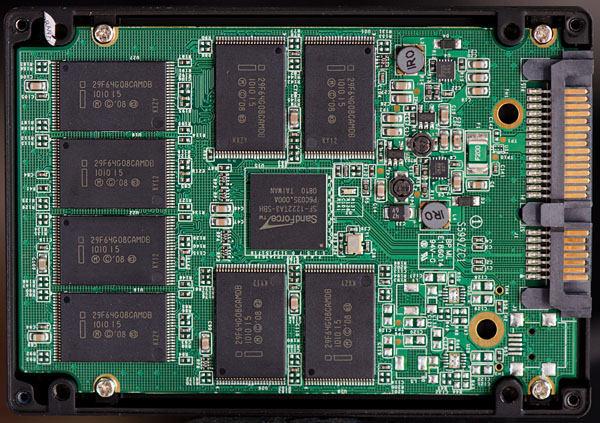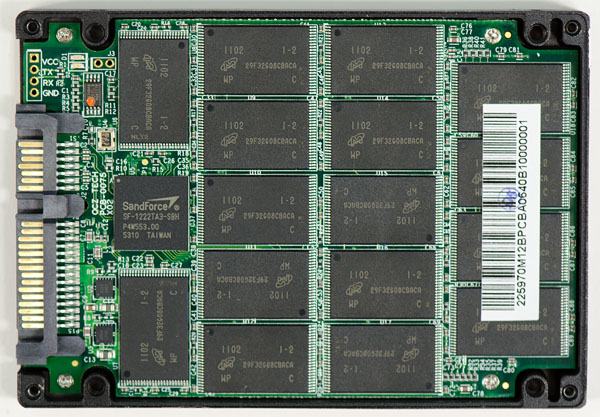The OCZ Vertex 3 Review (120GB)
by Anand Lal Shimpi on April 6, 2011 6:32 PM ESTThe Real Issue
While I was covering MWC a real issue with OCZ's SSDs erupted back home: OCZ aggressively moved to high density 25nm IMFT NAND and as a result was shipping product under the Vertex 2 name that was significantly slower than it used to be. Storage Review did a great job jumping on the issue right away.
Let's look at what caused the issue first.
When IMFT announced the move to 25nm it mentioned a doubling in NAND capacity per die. At 25nm you could now fit 64Gbit of MLC NAND (8GB) on a single die, twice what you could get at 34nm. With twice the density in the same die area, costs could come down considerably.

An IMFT 25nm 64Gbit (8GB) MLC NAND die
Remember NAND manufacturing is no different than microprocessor manufacturing. Cost savings aren't realized on day one because yields are usually higher on the older process. Newer wafers are usually more expensive as well. So although you get ~2x density improvement going to 25nm, your yields are lower and wafers are more expensive than they were at 34nm. Even Intel was only able to get a maximum of $110 decrease in price when going from the X25-M G2 to the SSD 320.
OCZ was eager to shift to 25nm. Last year SandForce was the first company to demonstrate 25nm Intel NAND on an SSD at IDF, clearly the controller support was there. As soon as it had the opportunity to, OCZ began migrating the Vertex 2 to 25nm NAND.
SSDs are a lot like GPUs, they are very wide, parallel beasts. While a GPU has a huge array of parallel cores, SSDs are made up of arrays of NAND die working in parallel. Most controllers have 8 channels they can use to talk to NAND devices in parallel, but each channel can often have multiple NAND die active at once.

A Corsair Force F120 using 34nm IMFT NAND
Double the NAND density per die and you can guess what happened next - performance went down considerably at certain capacity points. The most impacted were the smaller capacity drives, e.g. the 60GB Vertex 2. Remember the SF-1200 is only an 8-channel controller so it only needs eight devices to technically be fully populated. However within a single NAND device, multiple die can be active concurrently and in the first 25nm 60GB Vertex 2s there was only one die per NAND package. The end result was significantly reduced performance in some cases, however OCZ failed to change the speed ratings on the drives themselves.
The matter is complicated by the way SandForce's NAND redundancy works. The SF-1000 series controllers have a feature called RAISE that allows your drive to keep working even if a single NAND die fails. The controller accomplishes this redundancy by writing parity data across all NAND devices in the SSD. Should one die fail, the lost data is reconstructed from the remaining data + parity and mapped to a new location in NAND. As a result, total drive capacity is reduced by the size of a single NAND die. With twice the density per NAND die in these early 25nm drives, usable capacity was also reduced when OCZ made the switch with Vertex 2.
The end result was that you could buy a 60GB Vertex 2 with lower performance and less available space without even knowing it.

A 120GB Vertex 2 using 25nm Micron NAND
After a dose of public retribution OCZ agreed to allow end users to swap 25nm Vertex 2s for 34nm drives, they would simply have to pay the difference in cost. OCZ realized that was yet another mistake and eventually allowed the swap for free (thankfully no one was ever charged), which is what should have been done from the start. OCZ went one step further and stopped using 64Gbit NAND in the 60GB Vertex 2, although drives still exist in the channel since no recall was issued.
OCZ ultimately took care of those users who were left with a drive that was slower (and had less capacity) than they thought they were getting. But the problem was far from over.










153 Comments
View All Comments
casteve - Thursday, April 7, 2011 - link
Great review! Thanks for carrying the 120GB torch :)I'd love to see a couple of HDDs added to the 2011 bench (like they are in the 2010 bench) to keep the perspective in play.* Most people are still moving from an HDD to an SSD and not just upgrading their SSD's.
* stuff a 120GB SSD in yer laptop for $200 to replace a 5400rpm HDD and improve gaming IOPS by 5x is more impressive than replacing an existing 120GB SSD with a newer one for $250 and improve gaming IOPS by 10%. Extreme example...but you get the idea.
Gasaraki88 - Thursday, April 7, 2011 - link
I want to thank you for writing this article and keeping the companies honest. Without smart people like you, companies will overstate performance and to the common person it will look fine because we don't have the proper tools to test.I'll been reading Anandtech for 11 years now. The quality is still top notch unlike some other sites I used to go to.
cknobman - Thursday, April 7, 2011 - link
Dont buy OCZ products.Anand and countless consumer reviews from Newegg have proved that OCZ does not put out a consistent and reliable level of product.
Im not one for rolling the crap dice with my hundreds of hard earned dollars.
hackztor - Thursday, April 7, 2011 - link
LOL, okay go spend your hard earned money on last year performance intel new drives.seapeople - Thursday, April 7, 2011 - link
Wow you got him there! Yeah, why doesn't he just buy an Intel drive. That would be funny because then he would have to wait 5.6 seconds to open Photoshop instead of 5.2 seconds. Or it would take a full 33 seconds to reboot instead of 35 seconds. I bet he's so unintelligent that he would actually accept crappy last-generation solid state drive performance like that at a lower price.semo - Friday, April 8, 2011 - link
Corsair, patriot and many other SSD makers use SF controllers. You just have to be sure you know what firmware you're getting. You have to be much more careful with OCZ as you can't trust them to sell you what they claim on the box.Stargrazer - Thursday, April 7, 2011 - link
It's awesome that you're reviewing the 120GB version first. It's the version that I believe most people would be most interested in getting, so it's great that we'll be able to see how it performs, rather than only seeing the higher numbers of a ~256GB version that's so expensive that most people would never get it. It's fantastic even. Did I mention that it's awesome?Unfortunately, since the ~128GB versions haven't always been reviewed in the past, this also means that we don't really have much to compare the numbers to. How do we know if the 120GB Vertex 3 is competitive if we don't know the performance of its competitors?
I can understand if it might take a while to get the numbers for comparable versions of the 510, 310 and m4 (though I really hope that in the future you continue to press on for getting ~128GB versions in time for the initial reviews), but would it at least be possible to get the complete numbers for the 128GB version of the RealSSD C300? For some reason it doesn't seem to be in the IOmeter tests.
Oh. Isn't it time that you stopped using "I didn't expect to have to debut this so soon" in the introduction to the 2011 Storage Bench? :)
KenPC - Thursday, April 7, 2011 - link
A humorous thought of little relevance. but.. if OCZ rebrands the Vertex 2 as the 2b to solidify performance specs. then as I shop I will be thinking....Is this OCZ drive a 2b or not 2b, that is the question.....
Omid.M - Thursday, April 7, 2011 - link
They saw Anand's Vibrams and knew he meant business (casual).:)
sethm1 - Thursday, April 7, 2011 - link
I was looking forward to the Vertex 3 as being the next best thing.And so was hoping for a more positive review (but yes appreciate the candor in the review).
My question is, after all is said and done, is the Vertex 3 still better than the Vertex 2 (120GB versions)?
Should I go out and get a version 2?